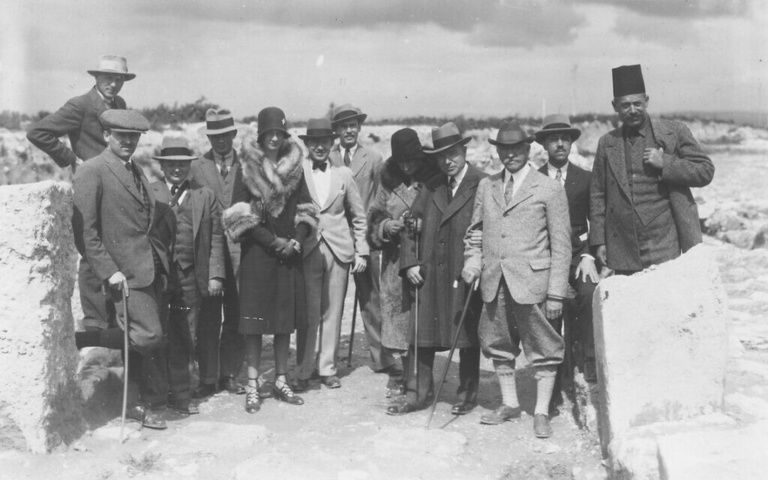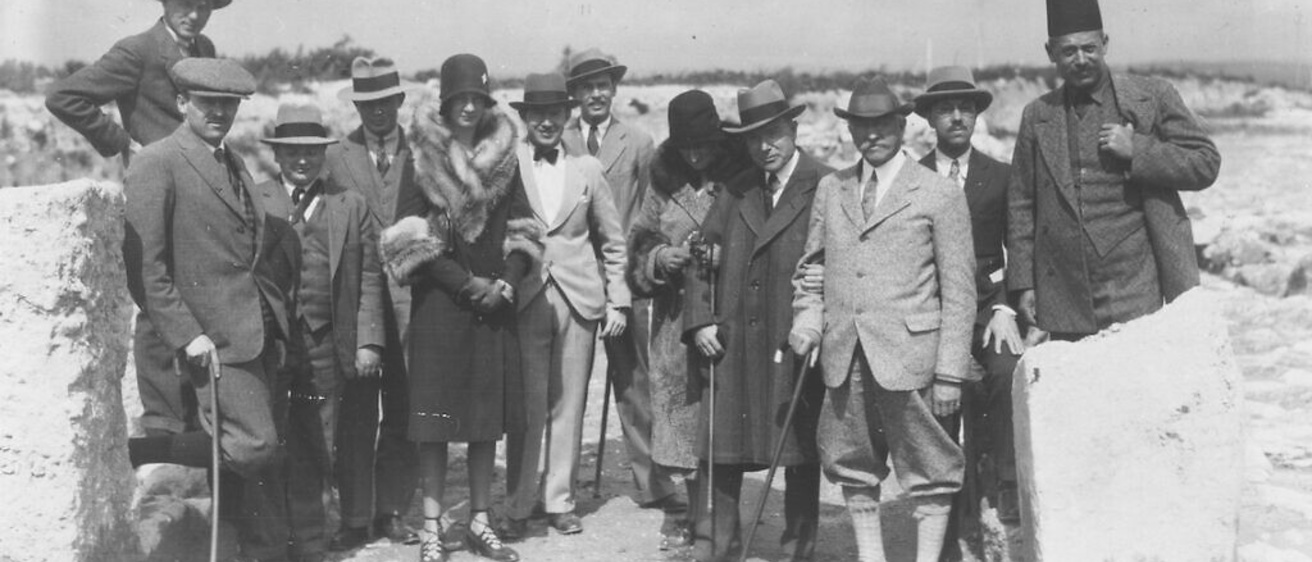
The archaeology of Israel started, as in many places in what was called the ancient "near east," as a foreign, even colonialist, enterprise.
Starting in the end of the 19th century, European powers sent expeditions to the Holy Land, then under the rule of the decaying Ottoman Empire, in a race to get a foothold in the main biblical mounds throughout what would become Israel and Jordan. Archaeological schools were established in Jerusalem such as the French École Biblique et Archéologique Française; the American Schools of Oriental Research (now American Society of Overseas Research, or ASOR); the Italian Studium Biblicum Franciscanum; alongside hospitals and churches. These were a part of a peaceful crusade, and, of course, fierce competition among the period's superpowers for position in the ancient land of the Bible.[1]
Most prominent during that time were the surveys and expeditions of the British Palestine Exploration Fund (PEF) and their projects in Tel es-Safi, Tel Azekah, Goded and Maresha and, of course, Jerusalem, alongside Schumacher’s German expedition at Megiddo and other sites.
The Ottoman law of antiquities, the first issued in 1874, was an attempt to curb the unchecked export of antiquities out of the empire, and into the major national museums of Europe and the United States. It is by no coincidence that the Ottoman Imperial Museum (now the Istanbul Archaeology Museum) was established in 1869 in the former Hagia Irene Church and needed its fair share of the Holy Land's archaeological spoils. While the Ottoman laws were extremely strict in regard to what can be done, and mainly, what couldn't, they were almost impossible to enforce, especially considering the frayed hold the central government had on the vast reaches of the empire. In the words of the Irish archaeologist R. A. S. Macalister, who worked in the Holy Land as part of the PEF, "During the Turkish rule everything was forbidden, but anything was possible."
In 1917, Turkish rule was replaced by a British one following the events of World War I. The British empire soon received the Mandate for Palestine from the League of Nations to govern Palestine and Transjordan, which included Eretz Israel, and established its Antiquity Ordinances. This law dictated that expeditions now had to receive a permit from the Department of Antiquities of the Mandate government, while the ownership of the artifacts themselves—and even the definition of antiquities—became clearer. The 1920's and 30's saw the "Golden Age" of foreign archaeology in the country, with the massive American-led expeditions such as the University of Chicago at Megiddo and Haverford College at Beth Shemesh. The study of the country's prehistory also emerged with Dorothy Gerrod's expedition in the caves of the Carmel.
Under the British Mandate’s Department of Antiquities, the first local Jewish and Arab archaeologists emerged. The department itself, still always under a British director, employed Jewish and Arab inspectors, and with the establishment of the Hebrew University of Jerusalem in 1925, followed by its Department of Archaeology in 1935, Jewish scholars began conducting their own excavations in the country. Such were the excavations at Beit Alpha by Eliezer Sukenik and at Beit Sheʿarim by Benjamin Mazar, among others.
While foreign activity almost stopped during World War II, the Israeli War of Independence in 1948 brought an end to the Mandate's Department of Antiquities and the establishment of an Israeli one—fully adopting the British Mandate's ordinance as Israeli law. By the end of the war, the "green line" dividing between the newly-founded State of Israel and the Kingdom of Jordan cut through the ancient land. The animosity between the two new political entities led to foreign archaeologists now having to "choose sides" when deciding on the location of their excavations, as in many cases, scholars who chose to work in Israel, were banned from working in Jordan.[2]
During the following decades, and through the 1967 Six-Day War, which led to the consolidation of the land west of the Jordan River under a singular Israeli rule, the continued presence of the European and American schools of archaeology in Jerusalem maintained the continuity of foreign archaeological activity in Israel which lasts to this day.
While archaeology in Israel began as a European and American colonial enterprise, things are gradually changing, and independent foreign archaeological activity in Israel is slowly coming to an end.
An infamous problem in Israeli Archaeology (and archaeology in general) is its massive publication gap. More and more, antiquities are regarded as a depletable resource in an antiquities-rich, densely populated country such as Israel, especially where there persists the ever-encroaching problem of modern development on the ancient landscapes and sites. Therefore, the Israel Antiquities Authority (IAA), established in 1990 to replace the Israeli Department of Antiquities, is growing reluctant to issue excavation permits to foreign expeditions unless they are partnered with a recognized, Israeli archaeological research institute.[3] This is, of course, not unique to Israel, as other countries around the Mediterranean are gradually demanding the participation of local scholars involved in each expedition.
This policy may appear strict to foreign eyes—even as a limitation on academic freedom. The core issue, however, remains the protection of cultural heritage. While the publication of an archaeological excavation is required by the Israeli law of antiquities, which was passed in 1978 to replace the antiquated British ordinances, this requirement is barely enforceable, even upon scholars and institutes based in Israel. The IAA's ability to enforce, or even penalize, foreign researchers and institutions is all the more limited, beyond the eventual ban of receiving further permits in the country in the event of misconduct or lack of suitable publication. Mandating that foreign excavations create partnerships with established Israeli institutes allows the Israel Antiquities Authority to strengthen its ability to enforce the law of antiquities, while simultaneously guaranteeing that most of the artifacts—considered by the law as cultural, state-owned, treasure—will be under the guardianship of local (Israeli) scholars and stored in Israeli universities, museums, or the IAA's own facilities. In addition, such partnerships increase each expedition's accessibility to advanced archaeological instruments and skilled professionals, which can be financially burdening when annually imported from abroad.
In a slightly ironic twist, this process is an ideological extension of one of the most novel intentions manifested in the British Mandate's antiquities ordinance: That the antiquities of the land, belong, first and foremost...to the land. While the British ordinance did allow regulated trade and export of antiquities and recognized a shared ownership of antiquities between the expedition and the government, the novelty was that it was the local government that owned the artifacts, as opposed to the imperial government as a whole, as the Ottomans had done in previous decades. As such, the antiquities found in Palestine\Eretz Israel were to remain, mostly, in their land of origin. And for their storage and display, the Rockefeller Museum in Jerusalem was founded.
While it is not the 1920's anymore, and the question of ownership and even the trade of antiquities has become clearer through the decades, the depleting nature of antiquities and the origin of the institutes that are permitted and entrusted with excavating them has yet to be fully determined. It is a messy process that must continue to be worked out over the next years and decades. Not all will agree on all decisions and policies.
The direction, however, is clear.
- Boaz Gross is the vice president of Israeli Institute of Archaeology, a non-profit organization which conducts salvage and community excavations across Israel, and provides logistic and financial and professional services to numerous expeditions from most archaeological institutes in the country, alongside foreign expeditions.
Gross is writing his PhD dissertation on the development of archaeological policy in Israel at Tel Aviv University.
boaz@israerliarchaeology.org
+972-526-935534
[1] See: Silberman, N. A. 1982. Digging for God and Country: Exploration, Archaeology, and the Secret Struggle for the Holy Land 1799-1917. New York. See also Gibson, S. 1999. British Archaeological Institutions in Mandatory Palestine, 1917–1948. Palestine Exploration Quarterly 131/2: 115–143.
[2] Lash, M., Goldstein, Y. and Shai, I. 2020. Underground – Archaeological Research in the West Bank, 1948-1967: Management, Complexity, and Israeli Involvement. Bulletin of the History of Archaeology 30/1: 8, pp. 1–11.
